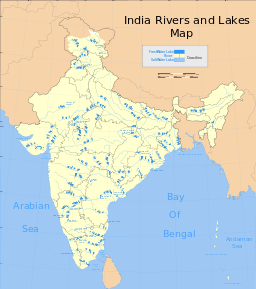Mahi River
| the Mahi | |
| River | |
| Country | |
|---|---|
| Source | |
| - location | Madhya pradesh, Vindhyas |
| Mouth | Gulf of Khambhat (Arabian Sea) |
| - location | Mahisagar District, Gujarat |
| Length | 580 km (360 mi) approx. |
| Discharge | for Sevalia |
| - average | 383 m3/s (13,526 cu ft/s) [1] |
| - max | 10,887 m3/s (384,471 cu ft/s) |
| - min | 0 m3/s (0 cu ft/s) |

The Mahi is a river in western India. It rises in Madhya Pradesh and, after flowing through the Vagad region of Rajasthan, enters Gujarat and flows into the Arabian Sea. It is one of three west-flowing rivers in India, along with Tapti River and the Narmada River. Most peninsular rivers in India flow in an easterly direction into the Bay of Bengal.
It has given its name to the Mahi Kantha agency of Bombay, and also to the mehwasis, marauding highlanders often mentioned in Arabian chronicles.
The exact position of Mahi River origin is Minda Village, which is situated in Dhar district Madhaya Pradesh.
Mahi River, stream in western India. It rises in the western Vindhya Range, just south of Sardarpur, and flows northward through Madhya Pradesh state. Turning northwest, it enters Rajasthan state and then turns southwest to flow through Gujarat state through the north of Vadodara city outskirts and enters the sea by a wide estuary past Khambhat after about a 360-mile (580-km) course. The silt brought down by the Mahi has contributed to the shallowing of the Gulf of Khambhat and the abandonment of its once-prosperous ports. The riverbed lies considerably lower than the land level and is of little use for irrigation.
The river Mahi is worshipped by a lot of people and has a lot of temples and places of worship along its shore. It is popularly described as Mahisagar due to the vastness of the river. The newly formed Mahisagar district in Gujarat derives its name from this pious river.
Dam
Banswara Dam
Mahi Bajaj Sagar Dam is a dam across the Mahi River. It is situated 16 kilometres from Banswara town in Banswara district Rajasthan, India. The dam was constructed between 1972 and 1983 for the purposes of hydroelectric power generation and water supply. It is the second largest dam in Rajasthan. It is named after Shri Jamnala Bajaj. It has many crocodiles and turtles in it. There are large number of islands within the catchment area of the dam, so Banswara also called popularly called as "City of Hundred Islands".The dam is easily accessible by road.The dam has an installed capacity of 140 MW.
Kadana Dam
it was built in 1979 in the villages of Kadana, Tal: Santrampur Dist: Panchmahals, Gujarat. It was constructed to provide irrigation, hydropower and flood protection.[2]
Wanakbori dam
The Wanakbori dam is established near Wanakbori village. The Wanakbori thermal power station uses the water of river mahi. There are 7 units for the production electricity.
References
- ↑ "Mahi Basin Station: Sevalia". UNH/GRDC. Retrieved 2013-10-01.
- ↑ "Narmada, Water Resources, Water Supply and Kalpsar Department- Kadana Dam".
 This article incorporates text from a publication now in the public domain: Chisholm, Hugh, ed. (1911). "article name needed". Encyclopædia Britannica (11th ed.). Cambridge University Press.
This article incorporates text from a publication now in the public domain: Chisholm, Hugh, ed. (1911). "article name needed". Encyclopædia Britannica (11th ed.). Cambridge University Press.- Mahi-Bajaj-Sagar
External links
| Wikimedia Commons has media related to Mahi River. |
- Mahi Basin (Department of Irrigation, Government of Rajasthan)
- (Narmada, Water Resources, Water Supply and Kalpsar Department)
- MAHI Leather - vintage leather bags coming from and named after the Mahi River 22°18'N., 72°37'E.
Coordinates: 22°16′N 72°58′E / 22.267°N 72.967°E